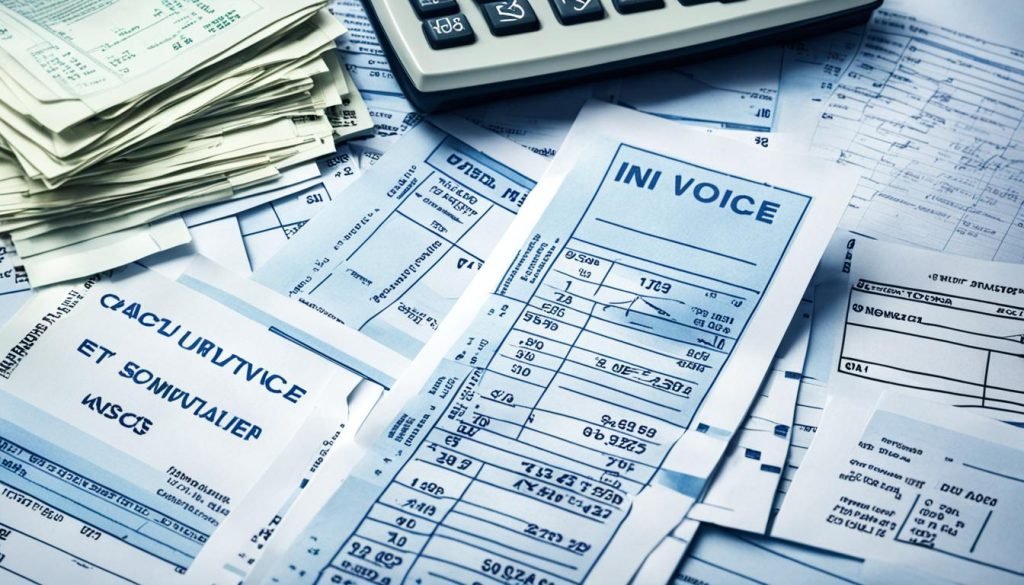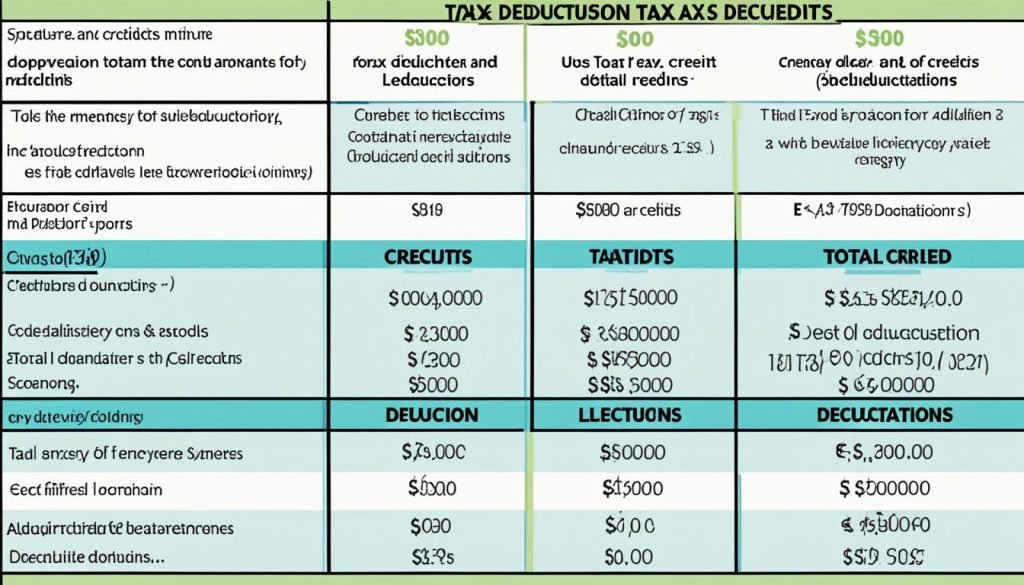Tax deductions can reduce what you owe and lead to more savings. By using deductions you qualify for, your tax bill can get much smaller. This lets you keep more money for other needs. To enjoy these benefits, just making sure you fit the rules for deductions is key. This guide will show you the different deductions you could take advantage of. It will help you know how to make the best decisions to save on taxes.
There are tax deductions for virtually everyone. Homeowners, parents, students, and business owners all have chances to save. Knowing what you can deduct and the right way to do it is important. It can help you keep more money in your pocket come tax time.
Key Takeaways:
- It’s crucial to know which tax deductions you qualify for to save more money.
- With the right understanding, you can lower your tax bill and perhaps get a bigger refund.
- Your ability to claim certain deductions might be based on things like owning a home, having kids, being a student, or owning a business.
- Making sure you claim deductions correctly is very important. Mistakes can lead to paying more or penalties.
- Getting advice from a tax pro or using tax software can help ensure you get all the deductions you’re eligible for.
Claiming Tax Credits for Lowering Your Taxes
Tax credits help cut your tax bill or offer a refund. You simply answer a few questions or fill in forms in your tax software. This way, you can get credits that lower what you owe or boost your savings.
There are many types of tax credits:
- The Earned Income Tax Credit
- Credits for parents or caregivers
- Education credits
- Retirement savings credits
- Credits for clean vehicles or home energy
To make the most of tax credits, first see which ones you’re eligible for. For instance, the Earned Income Tax Credit is aimed at helping those with low to moderate incomes. The amount you get depends on your income and how many dependents you have.
For higher education costs, education credits come in handy. They cut your tax bill by a part of your school expenses. This way, you pay less out of your pocket.
If you’re saving for retirement, there’s a credit for that too. Adding to your IRA or 401(k) lowers the tax you owe. It’s like getting a prize for saving for the future.
Plus, if you’ve made your home energy-efficient or have a clean vehicle, you could see more savings. These credits not only help your wallet but also help the planet.
How to Claim Tax Credits
To claim tax credits, first you need to know if you’re qualified. Then, follow these steps:
- Make sure you read the IRS’s rules for each credit. This is key to meeting all the conditions.
- Consider using tax software or a tax pro to guide you through the correct credits to claim.
- Fill in the forms accurately. Include all requested info and any needed proof for each credit.
- Finally, send your tax report in online or by mail. Check that all the credit details are right and true.
Understanding your tax credit options and how to claim them can really help you lower your taxes. But remember, being honest about your eligibility and facts is crucial to avoid trouble.
So, now you know how tax credits cut your tax bill. The next step is to look into deducting expenses. We’ll cover how this reduces what you’re taxed on in the next part.
Deducting Expenses to Reduce Your Taxable Income
Deductions are key to lowering how much tax you owe. By subtracting certain costs from your income, you can cut down your taxes. This could help you save more money. There are two main kinds of deductions: the standard and the itemized.
Usually, people go for the standard deduction. It’s a set amount based on your tax filing status. But if your expenses that *can* be deducted are more than the standard amount, itemizing could save you more. This means you list every eligible cost separately.
So, what can you deduct? Many costs can bring down how much of your income gets taxed. For example, alimony, some work-related costs for your car or home, retirement or health account contributions, student loan interest, and money you give to charities. Deducting these can help reduce your tax bill.
- Alimony payments: If you pay alimony because of a divorce, you can deduct it.
- Business use of a car or home: Using your car or home for work might allow you to deduct part of the cost.
- Contributions to retirement savings or health savings accounts: Money put into retirement or health savings accounts may lower your taxable income.
- Student loan interest: Interest paid on a student loan might be deductible.
- Charitable contributions: Money given to charities could lower your taxes while supporting causes you believe in.
Deciding between the standard or itemized deduction depends on your expenses. Keep in mind, itemizing means you need to keep good records. This helps to back up your deduction claims.
Let’s look at how deductions can change your tax amount with an example:
| Scenario | Standard Deduction | Itemized Deductions |
|---|---|---|
| Total Income | $50,000 | $50,000 |
| Deductible Expenses | – | $8,000 |
| Taxable Income | $50,000 | $42,000 |
| Tax Rate (Assumes 20%) | 20% | 20% |
| Tax Liability | $10,000 | $8,400 |
In this example, with the standard deduction, you’d owe $10,000 in taxes. But with itemized deductions, it drops to $8,400. That’s a $1,600 saving, thanks to deductions.
Understanding deductible costs and your choices can lead to saving more on taxes. This means more money stays in your pocket.

Popular Tax Deductions and Tax Breaks
When you want to lower your taxes and save more money, using tax deductions and breaks is key. Here are the top deductions and breaks that are highly sought-after:
1. Child Tax Credit
The child tax credit is a great help for families with kids. It lets you lower your tax payment for each child you can claim it for. This saves you a lot of money on taxes.
2. Medical Expenses Deduction
If you’ve had big medical bills, you can deduct them from your taxes. This is possible if your medical costs are more than a certain part of your income. It includes things like hospital stays, medicine, and ongoing care.
3. Mortgage Interest Deduction
Homeowners get to deduct the interest they pay on their mortgage. By doing this, you can lower the amount of tax you have to pay. It can save you quite a bit of money this way.
“Popular tax deductions, such as the child tax credit and medical expenses deduction, can provide significant savings for taxpayers.”
Also, there are other tax deductions and breaks worth mentioning. These include deductions for adopting a child, the earned income tax credit (EITC), giving to charity, and interest on student loans. They can all cut down on your tax bill, leaving more money in your pocket.
It’s super important to know about these tax deductions and breaks. They can make a big difference in how much you pay in taxes. Knowing them well can help you have a better tax situation.
Knowing these deductions and breaks can help you deal with taxes better. Always consider talking to a tax expert or using good tax software. This way, you make sure you’re getting all the tax benefits you can.
The Difference Between Tax Deductions and Tax Credits
When managing your taxes, it’s key to know the difference between deductions and credits. They significantly affect how much tax you pay or save. Let’s look at how deductions and credits differ to help you understand taxes better.
Reducing Taxable Income with Tax Deductions
A tax deduction lets you subtract an expense from your income that is taxable. This means you’ll pay taxes on less money. It can lower your tax bill.
For instance, making $50,000 and having $5,000 in deductions means you’ll be taxed on $45,000. This can save you money.
Dollar-for-Dollar Reduction with Tax Credits
Tax credits directly reduce the amount of tax you owe. They lower your tax bill dollar for dollar. This is different from deductions.
Imagine you owe $2,500, but you get a $1,000 tax credit. Your tax bill drops to $1,500. The credit cuts what you owe straight away.
Maximizing Tax Savings
Knowing how deductions and credits work is vital for saving on taxes. Deductions reduce taxable income. Credits directly lower your tax bill. Using both wisely can save you a lot.
Consider getting advice from a pro or using tax software. They can help find deductions and credits that fit your situation.
A Visual Comparison
| Tax Deductions | Tax Credits |
|---|---|
| Reduce taxable income | Dollar-for-dollar reduction in tax owed |
| Indirectly lower tax liability | Directly lower tax liability |
| Based on eligible expenses | Based on specific criteria and qualifications |
Note: The visual comparison highlights the main points about deductions and credits.

Now you understand deductions and credits better. Use them to cut your tax bill and save more. Keep up with new tax laws. Talking to a tax expert or using good tax tools can guide you for your taxes.
Conclusion
It’s key to know which tax deductions you’re eligible for. This knowledge helps lower your tax bill and maybe increase your refund. We’ve discussed many deductions and credits in this article. Using this information wisely can lead to big savings during tax season.
Focusing on eligible deductions and credits can lower your tax bill significantly. If you look closely at your expenses and pick the right credits, you can save money. Planning early and getting advice from a tax expert or using tax software is a smart move. It ensures you don’t miss any deductions you can claim.
Understanding tax deductions can greatly affect what you owe or get back in a refund. Being informed and taking the right steps now can save you money. Dig into the possible deductions that apply to you. Doing this will cut down your tax bill, giving you more control over your finances.







